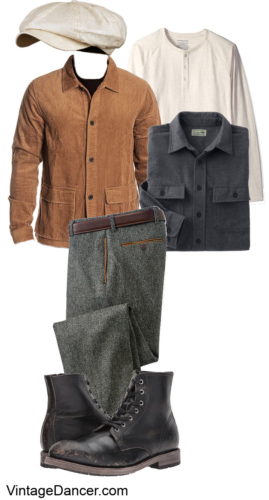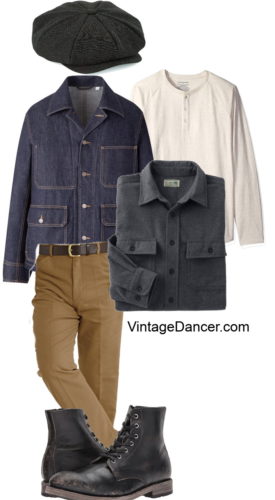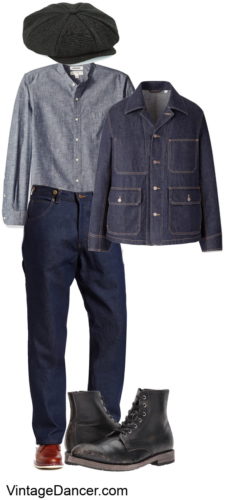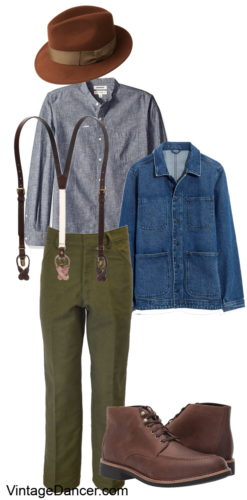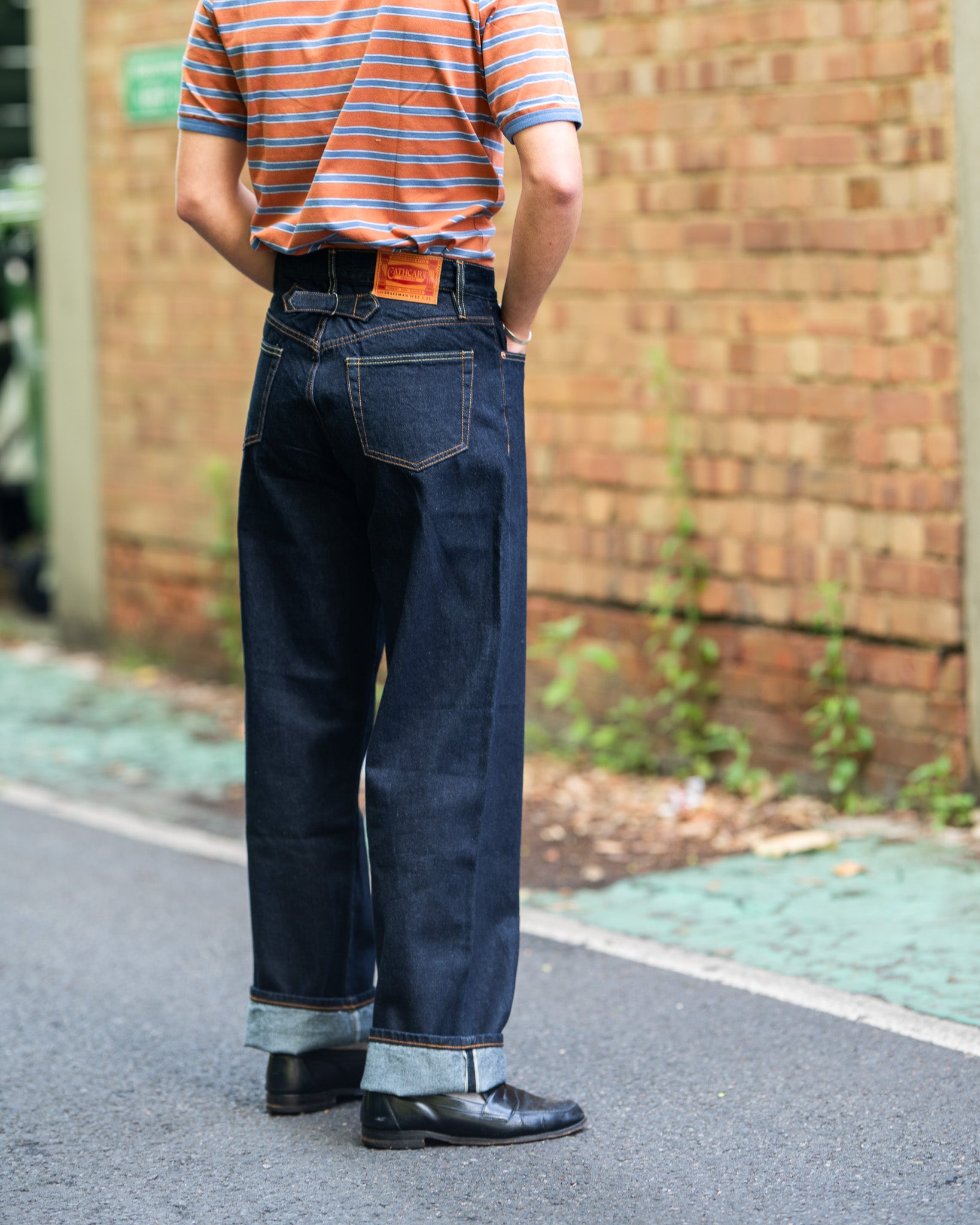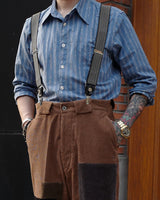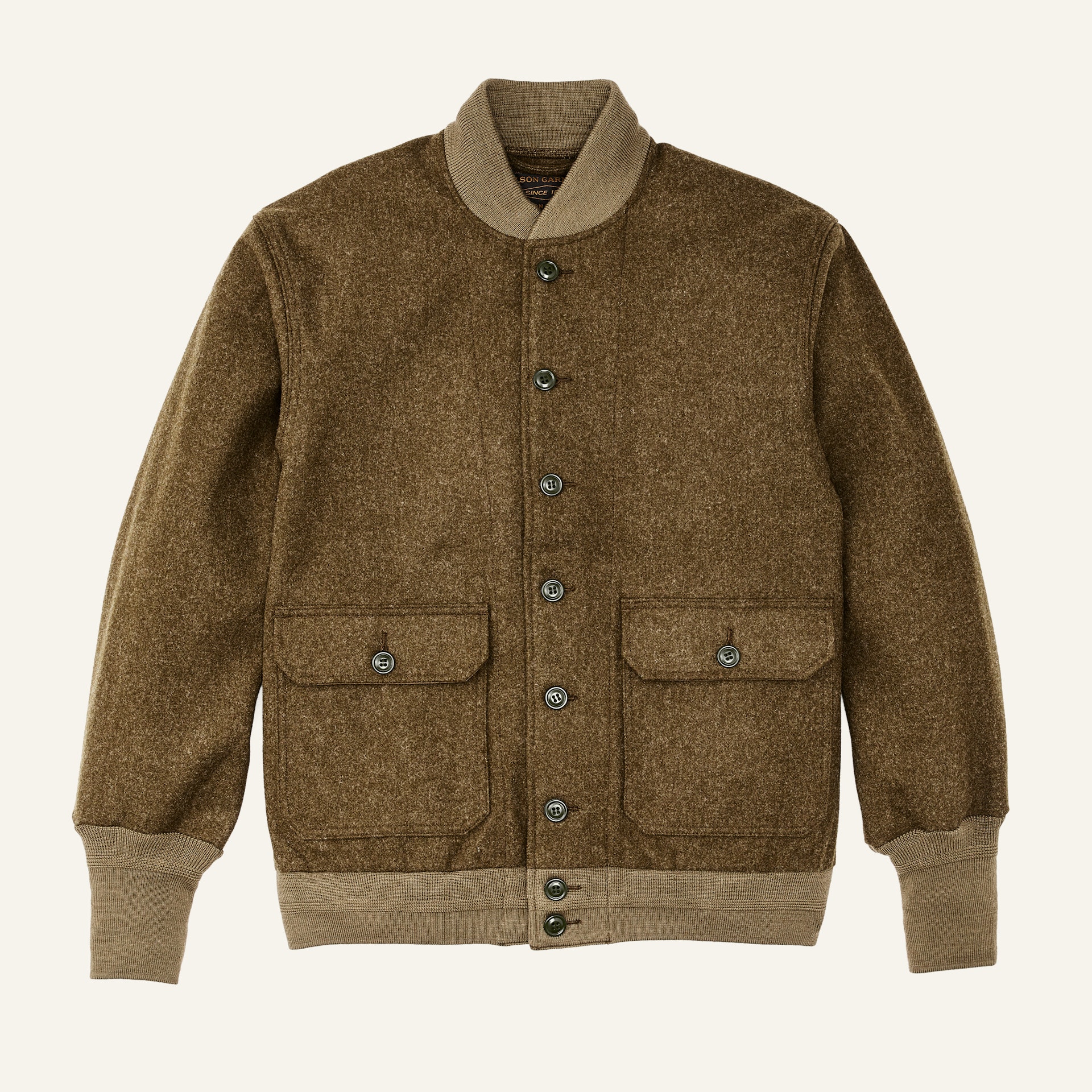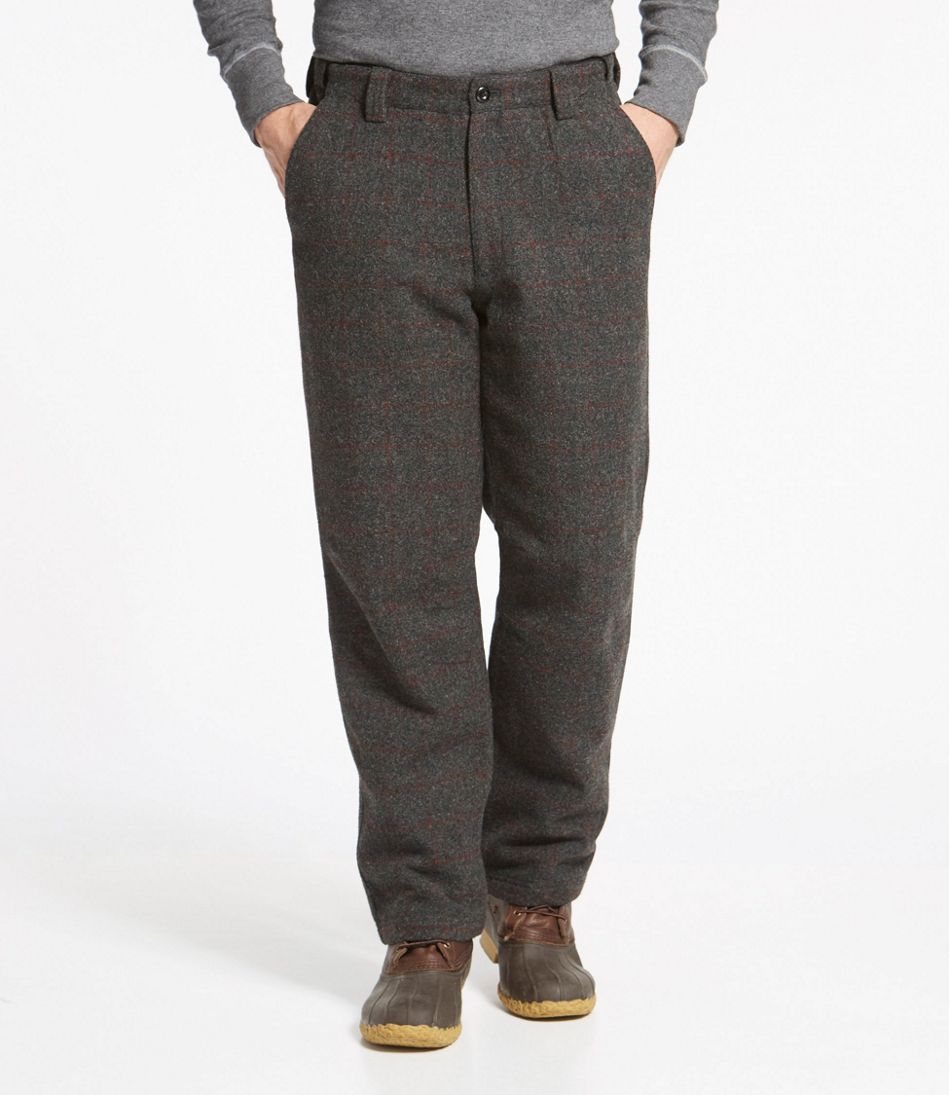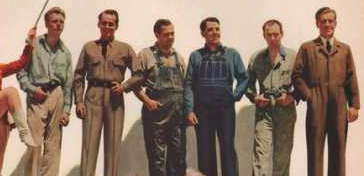
Men’s Work Clothing Styles- Overalls, Coveralls, Uniforms
Men’s Vintage workwear is quietly coming back in style. Mixing neutral colors with vintage accessories (caps, suspenders, scarves, boots) creates a timeless, casual, vintage menswear style. It is also a popular “costume” look for men who own classic cars and motorcycles or who want to dress casually for a themed event. Men’s vintage work clothes changed little from the turn of the century until the 1970s. Men had the choice of wearing overalls, coveralls, uniforms, blue jeans and jackets, and work boots for nearly every kind of physical occupation.
- Work Shirts – Two-pocket button down flannel shirts are back in style now. Denim or chambrey shirts over a cream Henley shirt (looks like vintage underwear) is casually stylish.
- Jackets. Denim or cotton chore jackets, wool bomber jackets, plaid zip up jackets, leather jackets, military jackets (WW2 era), Corduroy shirt-jackets, mackinaw jackets
- Denim Jeans – Levi’s makes reproduction jeans from the 1890s to 1960s. Wool, corduroy, tweed or heavy cotton wide leg pants are also very workwear looking.
- Overalls – There are a small handful of clothing companies that still make overalls. Blue denim overalls will be easier to find. Coveralls without elastic or zippers are the most vintage.
- Hats – Flat caps and newsboy caps are easy to find in shops today or online. A wide brim fedora is also a classic in neutral colors. Shop all men’s style hats here.
- Boots– Most leather workwear boots are still in the classic vintage styles. Justin Original and Red Wing have some of the best choices. Logsdonandco has workman’s boots based on a 1907 boot.
Learn more about vintage workwear by decade: 1910s men’s workwear, 1920s men’s workwear, 1930s men’s workwear, 1940s men’s workwear, and 1950s men’s workwear
Outfit Ideas:
- Fall fashion mix- Wool pants, flannel shirt, cord jacket, Henley undershirt, cap, boots
- Vintage or trendy now? You decide.
- Denim on denim workwear
- Everyday workwear or casaul- chambray shirt, denim chore jackets, wool pants, suspenders, fedora hat, boots
Vintage Workwear History
Lately, I have received quite a few questions about men’s vintage workwear from the 1920s to the 1950s. Readers want to know what types of clothing were worn to work as farmers, mechanics, groundskeepers, railroad men, delivery drivers, and other labor intensive “blue collar” occupations.
While the amount of written information about workwear is minimal, my vintage catalog collection has helped provide some examples of men’s clothing available to the working classes.
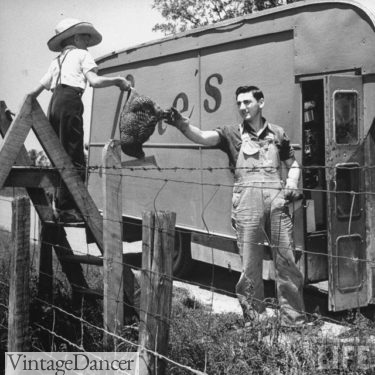
Delivery man wears overalls
Starting at the turn of the century and up to the 1960s, there was little change in men’s workwear styles. Materials, colors, and fit changed, but the overall style of workwear for common occupations remained the same. Overalls, coveralls, uniforms, and workwear separates made up the bulk of men’s vintage work clothes. A sturdy pair of work boots and a hat finished the look.
Read on for a general review of men’s vintage workwear or go in depth with workwear by decade: 1910s workwear, 1920s workwear, 1930s workwear, 1940s workwear, 1950s workwear.
Men’s Vintage Workwear: Overalls
Farmers, oilmen, miners, construction crew, and manufacturing workers may have chosen the classic denim overall to wear to work. Overalls were a one piece unit made of heavy denim cotton or duck cloth in blue, black, white, or blue and white thin stripes. Railroad men usually wore striped overalls and painters wore white. All other occupations preferred blue denim. Black denim was less common after the 1920s.
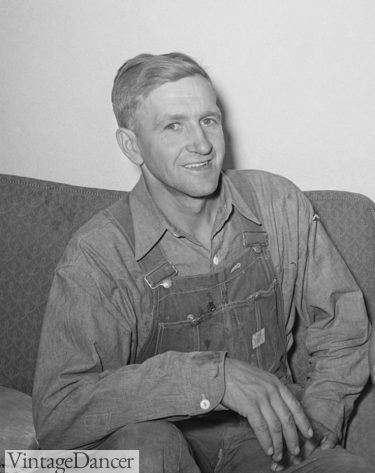
1940 overalls
The front bib often had one or many pockets to hold small tools. Additional large pockets were on the back of the of overalls as well as side pockets. For the early 1920s to 1940s, overalls had large fold-up cuffs (why? I am not sure). The fit of the coverall remained quite baggy from the 1920s to the 1940s, and slimmed down in the 1950s and 1960s to a fit you still see today.
The back of overalls had a few different styles. High back overalls brought the bib up the back in an upside down V and had straps extending over the shoulders. The low back style attached two suspenders, crossed in a low X to the back of the pant. The vest back extended the denim full up the back with a V cutout for the straps that continued over the shoulders.
Overalls were worn over a heavy duty wool or cotton long sleeve work shirt. A matching button up light jacket shirt provided additional protection of the arms, as well as more pockets.
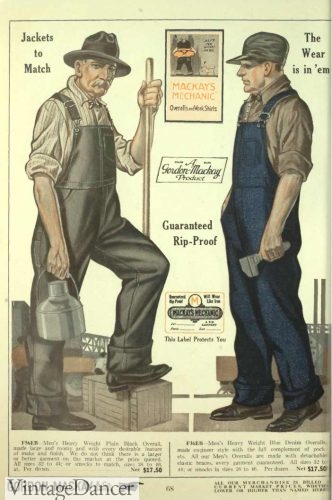
1922 Men’s denim overalls in black or blue.
Vintage Men’s Workwear: Coveralls
An alternative to overalls were coveralls, also called wearalls or unionalls. These were preferred by mechanics, aviators, and factory workers who needed to keep clean without straps, pockets, and shirt cuffs that could get tangled in machinery. The coverall was a one piece pant and shirt combination that buttoned up the front (or zipped after 1930).
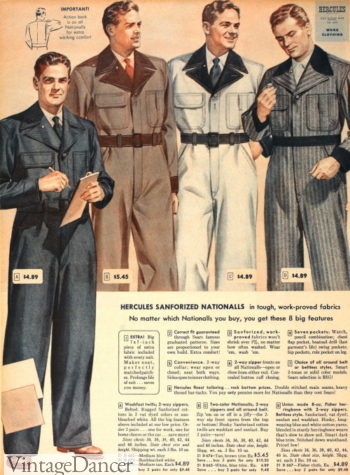
1948 coveralls -two-tone lapels
Blue or striped denim, khaki twill, white duck cloth, or any color of medium weight cotton provided a range of durability and hues. Two large chest pockets, side pockets, and sometimes a self fabric belt completed the style.
In the early 1920s coveralls buttoned up to the neck with a spread collar. The 1930s and onward featured open or notch lapels instead that were very wide in the early years and narrow by the 1950s. The coverall could be worn over other clothing or just over underwear in hot climates.
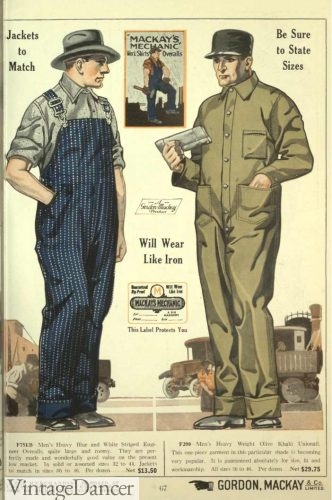
(right) 1922 Men’s plain Unionall / Coverall
Vintage Men’s Workwear: Matching Uniform Sets
For service oriented jobs that were not too dirty and required a uniformed appearance — such as gas station attendant, repairmen, gardener, delivery driver or shop keeper — a matching set of pant, shirt, and jacket was ideal. These uniforms could have a name tag or company name embroidered onto the shirt and jacket.
The colors were lighter than overalls and coveralls, with olive green being popular in the 1920s and 1930s followed by khaki, tan, blue, grey, and green in the 1940s and 1950s. Cotton twill or light weight wool were used instead of denim in solid, not striped, patterns.
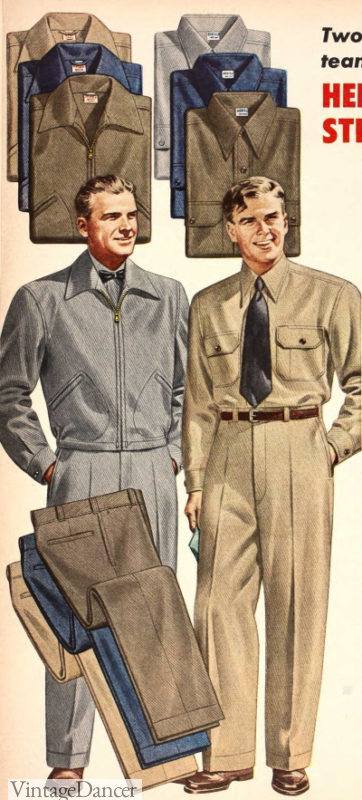
1951 mens workwear shirt, pants and jacket
The work shirt looked like a men’s dress shirt with two chest button pockets and button up collar. The work pants were flat front with a creased leg and cuff up until the 1950s. Belts were usually not worn with workwear until the mid 1940s.
The work jacket was a waist length button- or zip-up jacket with two pockets on the front or side. The style is similar to a Harrington, bomber, of golf jacket. They fit baggy on the torso but with a wide snug waist band up to the late 1940s, then slimmed down both in fit and tightness at the waist after that. By the 1960s, the waistband was gone all together. This straight jacket style is what is still worn today.
Men’s Workwear: Separates
As nice as coordinated sets looked and were required by many professional jobs, the vast majority of labor workers mixed their pants and shirts.
Work shirt separates were made of heavy duty cotton twill, denim, covert (wool or cotton) or chambray. Blue was the standard color, with khaki, army green and sometimes black as alternatives. In the early ’20s, shirts could come in thin stripes or small dots, but by the mid ’20s and onward, solid colors were preferred. Contrast stitching in a lighter shade than the body was one unique feature of a work shirt versus a dress shirt.
In winter, plaid was popular for the 1940s to 1950s. Most work shirts had two chest pockets with a button down flap.
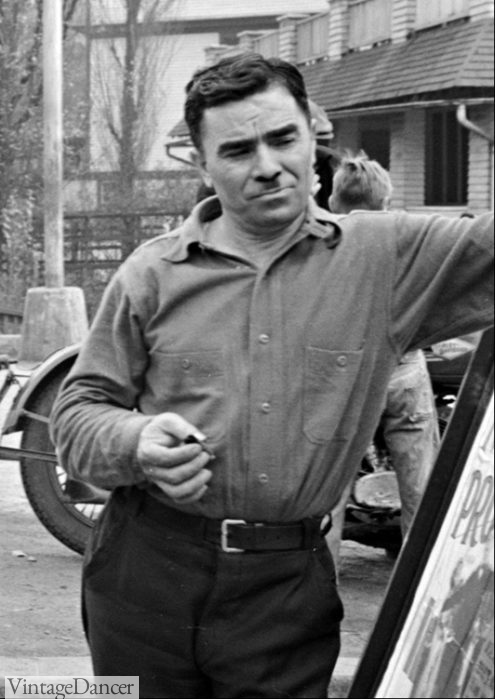
1935 mens work shirt casual attire
Men’s work pants could be denim blue jeans, a sturdy wool or cotton twill, or corduroy with a fit to match the decade. Common colors were dark blue, medium blue, grey, tan, striped blue or black, and drab brown. Large side pockets and back slit or flap pockets finished the pant. Denim blue jeans had their own style and details. Read the history of blue jeans here.
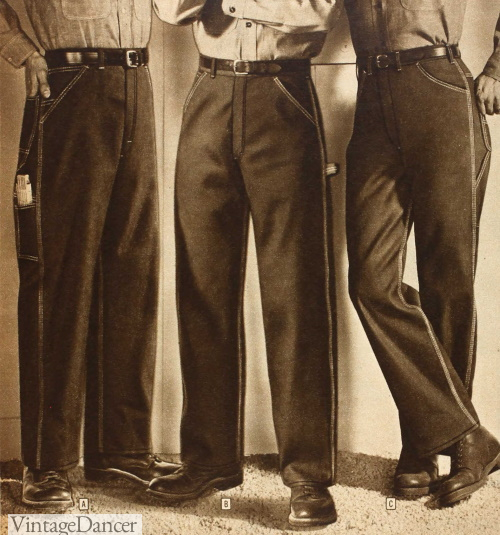
1959 slimmer fit blue jeans
Vintage Men’s Work Boots
Physical jobs required heavy duty boots for most occupations. Work boots from the teens onward had an overall similar style. Thick leather soles with moderate to large tread and a lace-up body that extended over the ankle and up over the calf. Rubber boots existed for wet jobs, but leather was good enough for most work environments.
It wasn’t just cow leather. Horsehide and even kangaroo leather were deemed more durable. Shades of brown and black were the only options. The shape of the toe box moved from round to square to narrow and pointed by the 1950s.
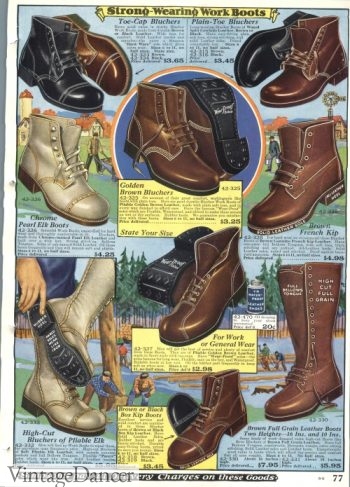
1928 Men’s work boots for winter
Men’s Work Hats
You may have noticed in many of the above illustrations that men were wearing hats. These were usually not nice felt fedoras or other gentlemen’s styles.
Instead, flat caps (also called ivy or newsboy caps) donned working men’s heads.
Shop caps with a baseball cap brim (also similar to cadet caps) were another workwear favorite. A striped version became iconic with railroad men and later took the name engineer cap.
More formal yacht caps came in white, blue or black for different uniform requirements.
Not pictured below would be large brim felt or straw hats popular with farmers or those who labored in the sun.
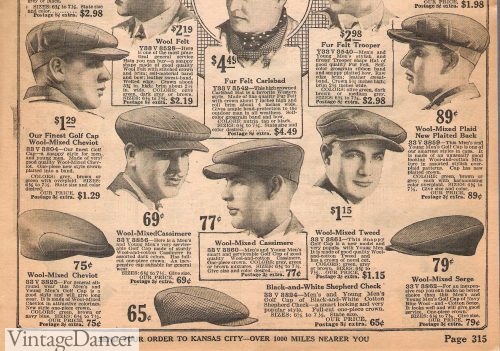
1922 Men’s caps suitable for work or leisure
Men’s Vintage Style Workwear Clothing:
See additional workwear reproduction and inspired clothing brands in this list.
Debbie Sessions has been teaching fashion history and helping people dress for vintage themed events since 2009. She has turned a hobby into VintageDancer.com with hundreds of well researched articles and hand picked links to vintage inspired clothing online. She aims to make dressing accurately (or not) an affordable option for all. Oh, and she dances too.
